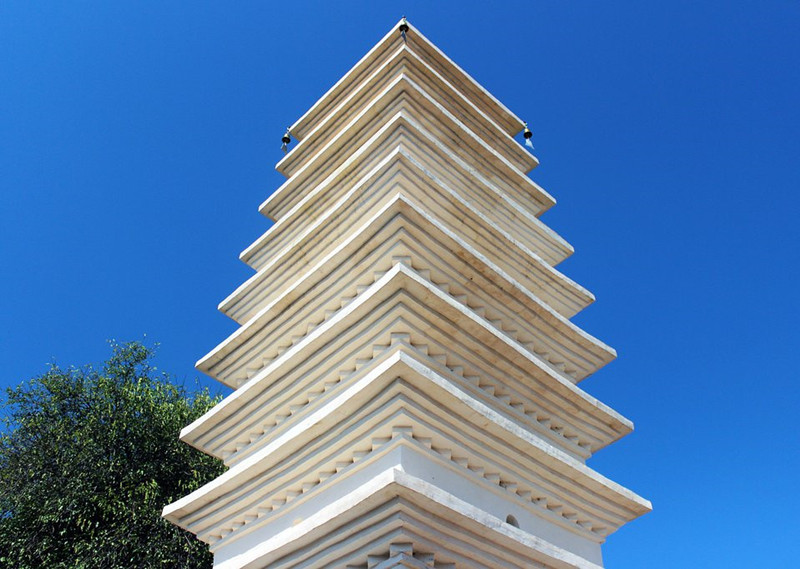
Dengjue Temple and Twins Pagodas in Weishan County, Dali
Overview
Dengjue Temple and its Twins Pagodas巍山县等觉寺和双塔, also known as Baoguosi Twin Pagodas (报国寺双塔), are located at the northeastern corner of Weishan County, Dali (大理巍山县城东北隅报国街). In 1988, these sites were designated as one of the first key cultural relic protection units at the state level in Dali Prefecture (大理州). The Twins Pagodas are nine-tiered, solid brick structures standing approximately 10 meters tall, with the eastern tower preserving only two tiers, reaching a height of about 5 meters. Constructed during the Ming Dynasty (around 1465), the pagodas were built by a local governor from the Zuo family, serving as a prominent feature of Dengjue Temple.
History of Dengjue Temple
Dengjue Temple (等觉寺), situated on the east side of Baoguojie in Nanzhao Town, Weishan County (巍山县南诏镇报国街东侧), was established during the Nanzhao Kingdom (南诏). It is the oldest Buddhist temple in Weishan and served as the residence for the Buddhist management institution during the Ming and Qing Dynasties. The temple underwent significant expansion during the Yongle period of the Ming Dynasty. The main hall, the Sun Palace (太阳宫), boasts impressive dimensions with a single eave and hip roof, measuring five bays wide (approximately 18.2 meters) and four bays deep (approximately 16.1 meters). The hall is surrounded by a corridor adorned with intricate bracket sets (斗拱) and decorative flower boards (花板). This architectural style reflects a solemn and ancient aesthetic, embodying elements of Song Dynasty (宋代) architecture.
During the Xianfeng period of the Qing Dynasty, the temple suffered extensive damage due to military conflicts, leaving only a few structures, including the Sun Palace. In 1939, the temple was repurposed as a health center, officially renamed the People’s Hospital of Weishan Yi and Hui Autonomous County (巍山彝族回族自治县人民医院) in 1958. In 1963, the Sun Palace was converted into a ward and was later used as a medicine warehouse for many years.
The Construction of the Twins Pagodas
In the first year of the Chenghua period (明成化元年) in 1465, local governor Zuo Lin (左琳) and his mother, Zhang Gongren (张恭人), constructed the Twins Pagodas in front of Dengjue Temple as Buddhist towers. Each tower rises over five zhang (approximately 16.7 meters) and has a circumference of four zhang and eight chi (approximately 15.8 meters). These nine-tiered, square pagodas feature niches housing stone Buddhas, with bricks inscribed with Sanskrit characters. The pagoda tops are adorned with copper finials, each standing seven chi tall, crowned with a golden lotus. Additionally, each tower is equipped with 24 wind chimes representing the 24 solar terms and a copper gourd atop the lotus cover.
Each pagoda features a marble inscription detailing the construction by Zuo Lin. Unfortunately, during the Cultural Revolution, the pagodas suffered significant destruction, with their upper sections demolished. One tower was converted into a water reservoir for practical use.
Architectural Features
Dengjue Temple (等觉寺), also known as Baoguosi (报国寺), is located at the northeastern corner of the ancient city of Weishan (巍山古城东北隅). It is the oldest existing Buddhist temple in the Weishan region and served as the residence for the Buddhist management office during the Ming and Qing Dynasties.
In the 16th year of the Yongle period (公元1418年), the monk Wuyong (无用) arrived from Yanshui, Jiangsu (江苏溧阳县), collaborating with local officials and benefactors to construct five courtyards with four rooms. By the second year of the Zhengtong period (公元1437年), the temple began to carve statues. The Twins Pagodas were built on both sides of the main gate in the first year of the Chenghua period (公元1465年), with benefactors contributing to the construction of additional halls. From 1599 to 1605, the Buddhist management office undertook repairs, adding new structures, including the rear halls and changing rooms, which featured sculptures of arhats (罗汉). This expansion marked the temple’s peak size; however, much was destroyed during military conflicts in the Xianfeng period, leaving only the Sun Palace and a few other structures. During the Guangxu period, a Lu Wei Shrine (禄位祠) was constructed to honor Lin Zexu (林则徐) on the left side of the Sun Palace, while the right side was transformed into a Zhao Zhong Shrine (昭忠祠) to commemorate those who died in battle.
Layout and Features
Dengjue Temple faces south, with the Twins Pagodas in front and the Sun Palace behind. The eastern courtyard features the Lu Wei Shrine, while the western courtyard houses the Zhao Zhong Shrine, and a garden is located to the southwest. The Twins Pagodas, originally built in the first year of the Chenghua period (公元1465年), are nine-tiered, square solid brick structures. During the Cultural Revolution, they suffered significant damage, with the eastern tower reduced to two tiers and the western tower reduced to six tiers. The Sun Palace, constructed in the 16th year of the Yongle period (公元1418年), features a single eave, hip roof, and impressive dimensions, adorned with heavy brackets and vertical columns. The building materials are coarse and ancient, contributing to its historical charm. In May 1998, it was announced as a cultural relic protection unit by the Dali Bai Autonomous Prefecture People’s Government.
Address: No. 1 Baoguojie, Weishan County, Dali, Yunnan Province (云南省大理市巍山县城东北隅报国街).
New Look of the Twins Pagodas
In 1988, Dengjue Temple and the Twins Pagodas were designated as cultural relic protection units by the Dali Prefecture People’s Government.
To alleviate population and industrial pressure in the core area of the ancient city, restore ancient relics, and showcase the millennia-old culture of Nanzhao, the Weishan County government invested 63.63 million yuan in 2015 for the relocation of the county hospital and the establishment of the Nanzhao Museum (南诏博物馆). The museum integrates cultural heritage display, collection, academic exchange, and historical cultural research, greatly enriching the cultural life of local residents and promoting the development of related tourism industries. It has become a vital venue for Weishan’s external publicity, cultural exchange, tourism reception, and a key base for youth patriotism education and social science popularization.
How to Get There
To reach Dengjue Temple and the Twins Pagodas, you can take public transportation or drive to Weishan County. The nearest major city is Dali (大理), from which you can hire a taxi or take a local bus. The drive from Dali to Weishan takes about one hour, covering approximately 60 kilometers. Public buses run frequently between the two locations.
Travel Tips
- Best Time to Visit: Spring (March to May) and autumn (September to November) are ideal for pleasant weather and vibrant scenery.
- Respect Local Culture: Be mindful of the religious significance of the temple and pagodas; dress modestly and behave respectfully while visiting.
- Photography: Capture the stunning architecture and landscapes, but avoid intrusive photography during religious ceremonies.
- Local Cuisine: Explore local dishes at nearby restaurants to experience the unique flavors of Weishan County, such as “Weishan Roast Duck” and “Mushroom Hot Pot.”
- Guided Tours: Consider joining guided tours for a more enriching experience, as local guides can share detailed insights about the temple’s history and architecture.
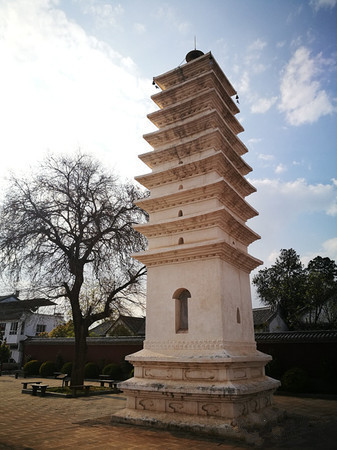
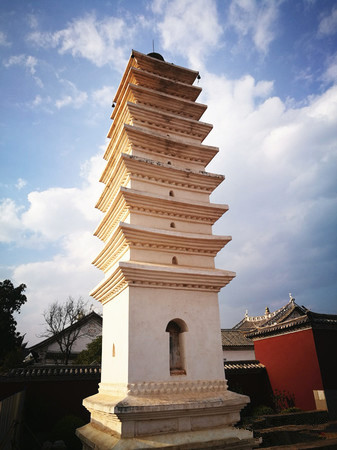
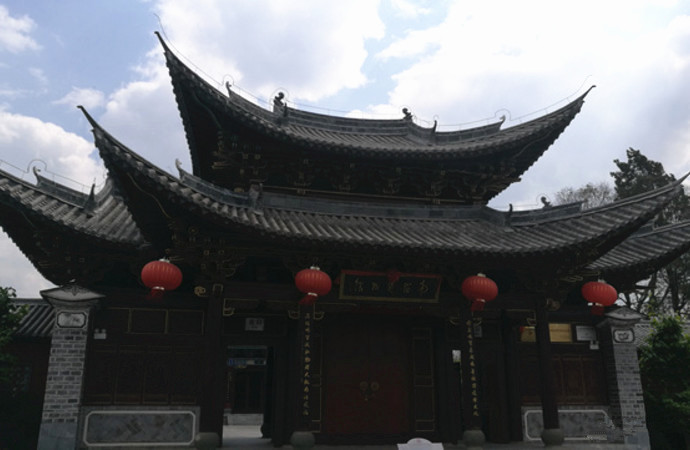
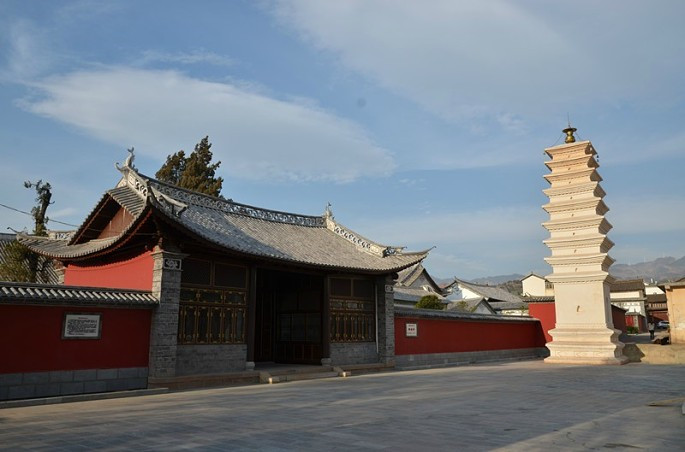
Location:
